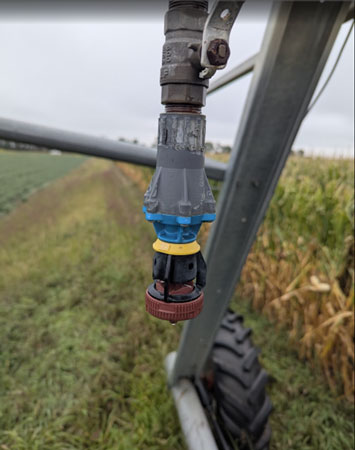Above-average temperatures in early October may have delayed thoughts of winter, but colder weather and freeze warnings have now arrived in parts of Kansas—especially in the west. Many irrigation system startup problems in spring are caused by preventable winter damage. Taking time now to properly winterize your system can prevent costly repairs and ensure a smoother start next season. Off-season inspections also provide a great opportunity to make improvements and repairs before spring fieldwork begins.
Park pivots and linear moves in a safe location
- Wire theft is less likely when the machine is in a visible but inaccessible area of the field.
- Wind damage is less likely when the pivot points into or away from the prevailing wind compared to perpendicular to the wind direction
- Rodent damage is lessened when machines are at least 100 feet away from tree lines.
- Protect or surround the entire machine with an electric fence if grazing will occur in the field.
Drain pivots and linear move systems
- Check for plugged automatic freeze drains, as this can lead to major repairs if not caught in a fall inspection.
- Most of the currently designed pivots have automatic freeze drains that drain the main overhead pipe
- Clean and drain rock traps.
- Ensure all Pivot supply lines, end gun supply, and hydro control hoses are drained, even if they are installed to allow drainage. Sagging hoses can hold water and lead to damage.
- Remember to cap all large openings into the system to prevent bird nesting.
- If the linear move has a large hose, placing buckets on the ends to ensure animals don’t nest in the pipe during the off-season is key.
- Ensure all drain hoses are released and drained at the control panel if the system includes them. These are found at the bottom of the control panel. These small hoses can freeze and cause damage to the control box, but make sure the hoses are tucked if left unattached to protect from animals.
- Ensure all nozzle drops and nozzles are drained, as any trapped water can crack regulators and sprinkler bodies

Figure 1. An irrigation system nozzle body can trap moisture that freezes and damages plastic bodies. Photo by Tina Sullivan, K-State Research and Extension.
Pump down or drain underground pipelines
- Most underground pipelines are buried deep enough to prevent freeze damage but often require pumping or draining enough water from them to empty the upper portion of Z-pipe risers and pump manifolds. This is typically done by purging the system with air or modifying a fertilizer transfer pump to pump system at its lowest outlet or inlet points.
- Remember to cap all pipe inlets and outlets to prevent rodents from entering.
- Ensure all irrigation risers are marked to protect from being hit in times of high snowfall.
Drain the pumping station
- Drain pumps and manifold to the lowest point.
- Replace brass drain plugs if damaged.
- Well-designed pump installations will be easy to drain without stripping drain plug threads or the need for air purging.
- Inspect gauges, supply, and control wire for need of repair.
- Service engine with attention to engine oil, bearing and seal lubrication.
- Check cooling system for adequate anti-freeze level and concentration.
- Drain the fuel tank to reduce water accumulation and potential theft.
- Remove any gauges that are not graded for winter conditions and replace with plugs for the winter.
Inspect and lock down electrical power supplies
- Locking down electrical power supplies helps prevent vandals from turning wells and pivots on midwinter and minimizes potential electrical system damage.
- Inspect each electrical box in the system from power supply to the last pivot or disconnect on system line for damage and holes that may be an access for rodents.
- Inspect the grounding connection and the grounding rod and test the resistance.
Inspect tires and wheel tracks
- Check drive trains/ wheel gearboxes for each tower to ensure wires are tucked or maintained
- Check for correct air pressure in each pivot tire.
- Check pivot tires for any sidewall damage and consider using the off-season to replace tires if they are struggling to hold air or could be considered a safety hazard due to UV cracking.
- Consider filling or tilling any rutted pivot wheel tracks, which will allow your center pivot irrigation system to run properly and reduce stress on tillage and harvest.
- If your wheel tracks are too deep, consider the variety of options available for this problem (i.e., filling in with gravel).
Explore options for reducing monthly energy bills
- Consider contacting your power supply company to investigate turning off the power system to save energy costs.
Create a winter work list for each system
- List the improvements and repairs needed for each system while it's fresh in your memory.
- As you are inspecting and winterizing your system, add any other areas needing attention to the list of repairs needed, such as the U-joint between the gearbox and gear motor, tires, sprinkler packages (nozzles, pads, regulator), etc.
- Assign the repair to someone, whether it is your people or the local irrigation dealer repair crew.
Tina Sullivan, Northeast Area Agronomist
tsullivan@ksu.edu
Jonathan Aguilar, Water Resources Engineer
jaguilar@ksu.edu
Tags: irrigation equipment winterization